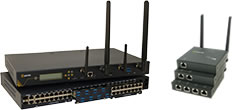
How edge computing can strengthen network infrastructure
By Max BurkhalterJanuary 16, 2018
Companies wishing to maximize their productivity and give themselves better business tools are investing heavily in the internet of things. The IoT is the network connection between smartphones, tablets, printers, even some thermostats - all of these machines produce data that can be stored and analyzed. It is a level of insight that has never before been possible in American businesses.
However this much data can be unwieldy. A company with one central location would need to spend a lot on communications bandwidth to collect remote data, even with established information collection centers. This process can be expensive, forcing companies to spend needlessly on data retrieval.
Creating an effective edge network helps reduce the time and money needed to process data from remote IoT-enabled devices.
"Edge computing places the data collection very close to the point of input."
What is edge computing?
Edge computing turns the idea of gathering data on its head. Instead of leeching information from multiple sources to one spot for processing, edge computing places the data collection very close to the point of input. For example, a weather station hoping to gather data from a sensor at the north pole could process the data there before feeding it to its data center in New York, rather than transporting the data thousands of miles before any feedback is provided.
Edge computing leans on IoT-devices extensively, whether they are smartphones or sensors. It is for vast swaths of data that would take too long to transmit to the cloud. For instance, GE used the example of driverless cars. These automated vehicles are set to generate 40 terabytes of data roughly every eight hours. Even in a low-latency setting, it would take time to process this data effectively with only cloud computing - data that might be vital to improving a safety feature and preventing a crash.
Edge computing can be helpful at companies looking to generate predictive analytics (knowing when machines need maintenance before they break down), provide flexible device replacement and more energy efficient management. It will enable faster machine learning as the devices will be able to process and evolve on location.

Capturing the mobile edge
Edge computing requires more than just smartphones and tablets to function effectively. Since the cloud and WiFi have limited and inconsistent speed, the best approach is to strengthen wired infrastructure. For example, remote power switches automate a vital process in keeping data collection moving at a consistent rate.
Without a RPS, machines simply continue working until they overheat, shut down or experience some other technical glitch. At which point, an employee is required to travel to the location and reset the power manually, staying nearby to test and ensure the device is working properly. Perle's RPS is an intelligent switch, meaning it will automatically turn the machine off in certain situations, such as when a system is overheating.
Devices like switches, converters, extenders and similar equipment are all helpful in enabling a strong edge network. Serial Console Servers, like the Perle IOLAN Console Server, are also useful tools as these allow companies to manage these devices in addition to maintaining firewalls and providing tweaks to the Windows OS.
Perle's products strengthen the data streams between devices, allowing sensors, smartphones and other remote data collection tools to function more productively on a regular basis.
With the majority of industries continuing to embrace IoT-enabled technology, edge computing will be needed to more effectively take advantage of remote data collection. Perle provides the hardware to enable the critical network infrastructure required for uninterrupted data streaming at lower bandwidths. Connect with us today to learn more about how we can help your company upgrade its hardware for effective edge computing.



